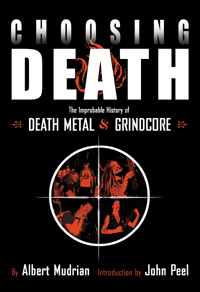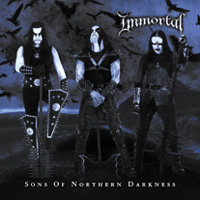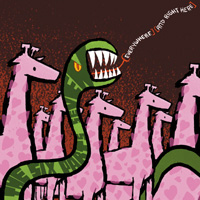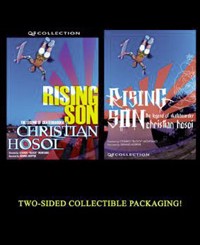 Choosing Death
Choosing Death
The Improbable History of Death Metal and Grindcore (Feral House)
By Albert Mudrian
by Tim Den
Choosing Death: The Improbable History of Death Metal and Grindcore is a book about the “who”s, “where”s, “what”s, “when”s, and – most importantly – “why”s of a movement that won our hearts and gave us a place to belong. The ancestors (Possessed, Slayer, Venom), the forerunners (Napalm Death, Morbid Angel, Repulsion, Death), the friendships, the gaining of popularity, the band and label dramas, and, of course, the music. It’s the first literary statement to boldly claim both genres’ worth in musical history.
The chapters – cleverly named after songs by Terrorizer, Napalm Death, Morbid Angel, and Death – meticulously map out how both grindcore and death metal sprung to life in Birmingham and Tampa and all over the world. Aligned semi-chronologically, it traces the beginnings to Napalm Death and Earache Records, following their stories as well as their impact on the musical market place. Priceless anecdotes abound (Mick Harris and Steve Charlesworth’s drum battles to see who could blast faster), perfectly conveying the “we had no idea what the fuck we were doing, but something was happening” mentality of the bands at the time. As with all revolutionary art, these barely legal kids stumbled upon the fastest and most brutal music known to man purely out of naivete.
Along with the big names, the book also covers some relatively unknowns, and it’s hard to argue with a book that digs so deeply into the infamous Earache/Columbia joint venture. The success of Earache led to an early-’90s distribution deal with major giant Columbia that turned bands, personal relationships, and creativity into a very fucked up cesspool, out of which not many survived. I myself had always wondered what exact drove Carcass to implode, Napalm Death to slow down, and Entombed to use Marvel Comics characters. I wonder no more. If there’s one lesson to be learned here, kids, it’s that business kills art. It’s as simple and truthful as that.
Reading about how every member of Morbid Angel worked at the same car wash in order to support themselves, how drummer Pete Sandoval practiced double bass 12 hours a day in order to join the band, and how Mick Harris took four-and-a-half hour weekly train trips to practice (for a second band, no less) just cements my belief that these guys deserve more credit than the world has ever given them. Punk had the attitude and metal had the technical prowess, but it wasn’t until grindcore and death metal that the two were combined. These guys were the rough-n-toughs from the streets, and they could play like the arena rock spandex-panted. And what other genre boasts the number of mutations that emerged out of the initially darkened spewage? Death and Carcass would lead a melodic revolution, Napalm Death and Godflesh would introduce apocalyptic (almost industrial) rhythms, Sepultura and Fear Factory would pave the way for nü metal, and Roadrunner bands like Cynic, Believer, Pestilence, and Atheist would erect a tower all their own in the intertwining of jazz and metal. Not all became popular, but almost all became greatly influential.
This book is for us, the faithful. The kid who saved his lunch money every day in order to buy a new tape every weekend. The three outcasts in every school who clung onto their dignity, identity, and devotion to something entirely their own, no matter how much ridicule they took for it.
(www.feralhouse.com)



